Protein powder is a large part of my everyday life. I use it in recipes, mix it with water to drink during workouts, and use it when I’m unable to reach my desired amount of protein for any day. If you have seen any of my recipes, I typically give my protein powder recommendations with quality and cost in mind. Still, I receive a ton of questions about protein powder and wanted to put together a comprehensive guide for all protein powder-related information. I’ll be sure to update this as I come across new questions or areas of interest. For now, we’ll take a look at:
- How to analyze cost and ingredients in protein powder to see if you’re overpaying
- The difference between whey concentrate, whey isolate, and hydrolyzed whey and when it makes sense to pay for each
- How to calculate a protein powder’s percent protein and another look at cost per gram
- Busting the myth of being able to only absorb 25 grams of protein per meal
- How to analyze any supplement or product to tell if it’s going to work or worth the money
How to Tell If You’re Overpaying for Protein Powder
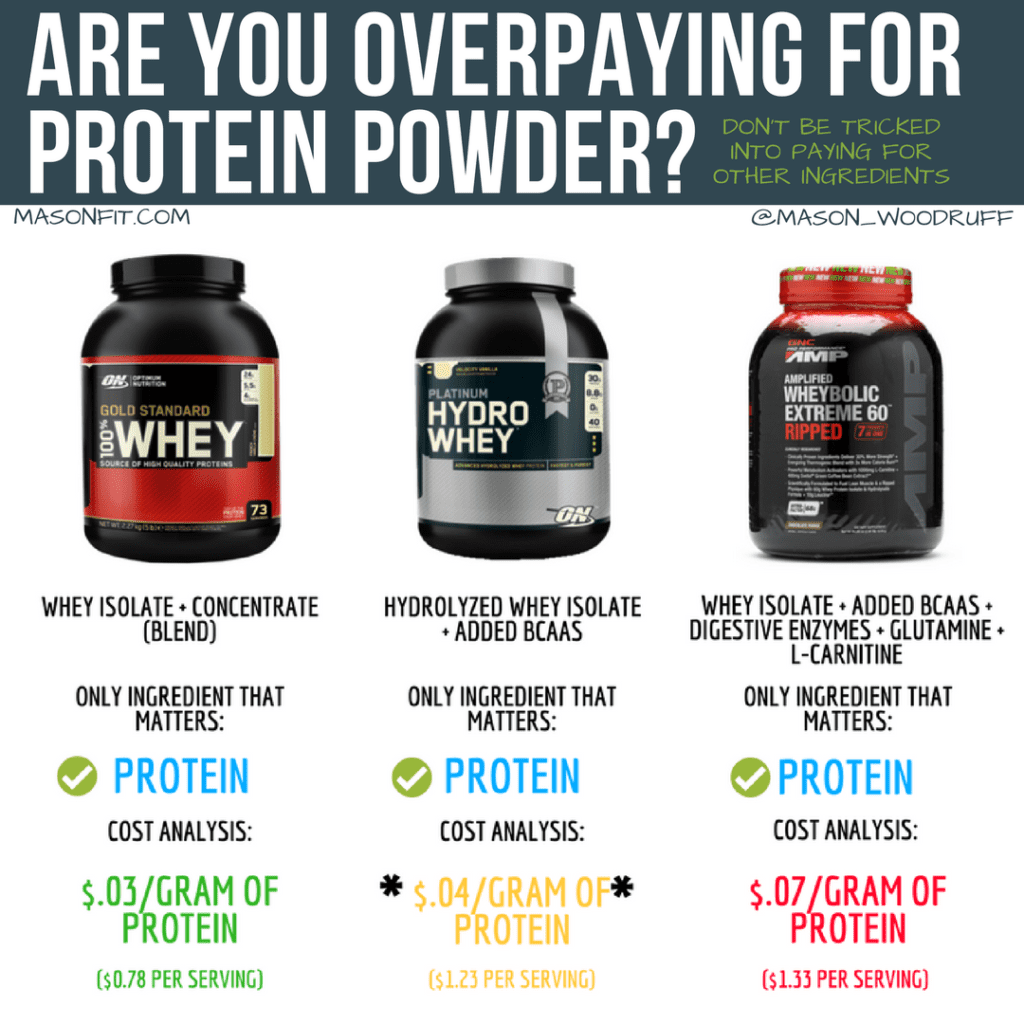
While I don’t like to classify protein powders as supplements because of their food-like macronutrient composition, they are undoubtedly the most popular product in the supplement industry. This popularity has led to every company under the sun developing ultra-special formulas from every source imaginable. You can find dairy-based whey, egg, soy, hemp, pea, blends, and more. In addition to the source, these have different classifications like concentrates, isolates, hydrolyzed, cross-micro-cold-filtered, and other crazy terms.
So, what’s the difference?
As you can probably guess by now, the difference is slight. Every source will be coveted as the holy grail of protein, but whey seems to reign supreme. The amino acid content — or the building blocks of protein — of whey outshine other sources in terms of favorability for muscle hypertrophy and recovery. Unless you’re avoiding animal products or lactose, you should go with whey. If you go with a plant-based protein, I’d suggest a blend.
As for the fancy filtration and processing, the differences between absorption rates seem to be too small to justify the increase in price. Unless you’re an elite athlete, the potential benefits of fancier processing methods aren’t worth your time or money.
Note: I do recommend a whey isolate like Hydrowhey because of its improved digestion in those with lactose intolerance or even the borderline intolerant. You also get fewer carbs and fats with most isolate powders. And as far as price goes, keep reading.
The number one thing I can recommend is to look at the price per serving, price per 25g of protein, or even price per gram of protein. As you’ll see in the images in this post, you can break the price down as far as you want to get an accurate view of what you’re paying for protein. Sometimes, the price per serving could be skewed by the actual protein per serving. Your goal with protein powder should be to get one thing – protein – and nothing else.
The cost per serving may not always be the best way to determine value. You’ll see the cost per gram of protein is closer than you might think between Gold Standard and Hydrowhey. Break it down for the best deal.
What’s the Difference Between Whey Concentrate, Whey Isolate, and Hydrolyzed Whey?
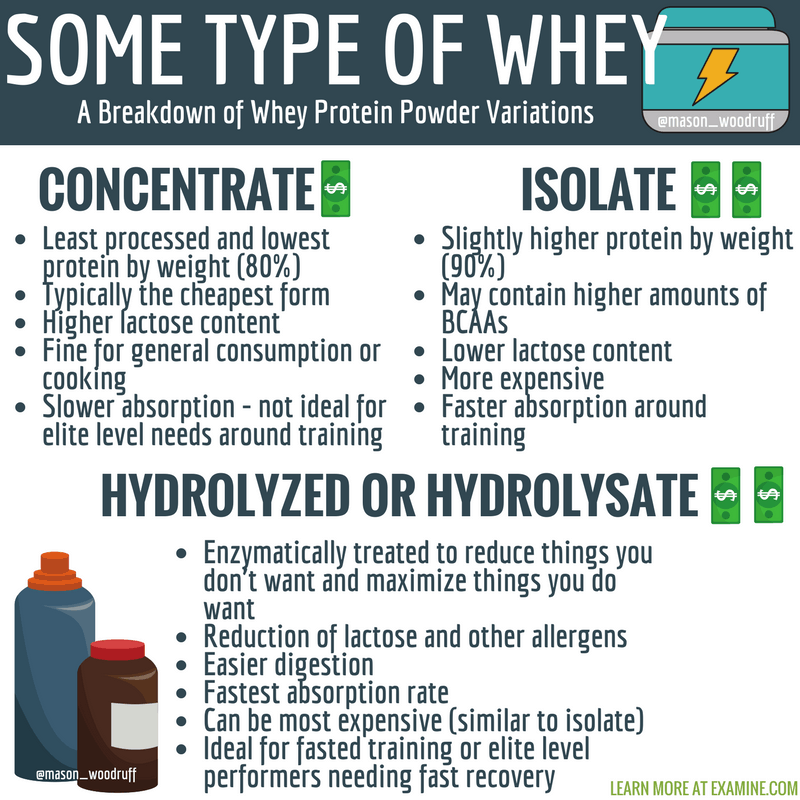
Overall, unless you’re lactose intolerant, have an allergy, or need fast absorption and maximum BCAA load, a whey protein concentrate may get the job done. If you’re wanting to do what’s most optimal, an isolate or hydrolyzed isolate may be the better choice.
Also, you can find plenty of “blends” with several different types of protein together. Be careful with these as you may or may not know how much of each type you’re getting. Look for full disclosure or percentages of each type in the blend.
Match your protein to your goals and level of commitment to training. There’s no need to pay more for higher end protein if you’re not training hard.
While protein supplements aren’t necessary, they can be a valid whey way to meet higher protein goals. Still, you should be eating plenty of whole food protein sources.
More on Analyzing Your Protein Powder
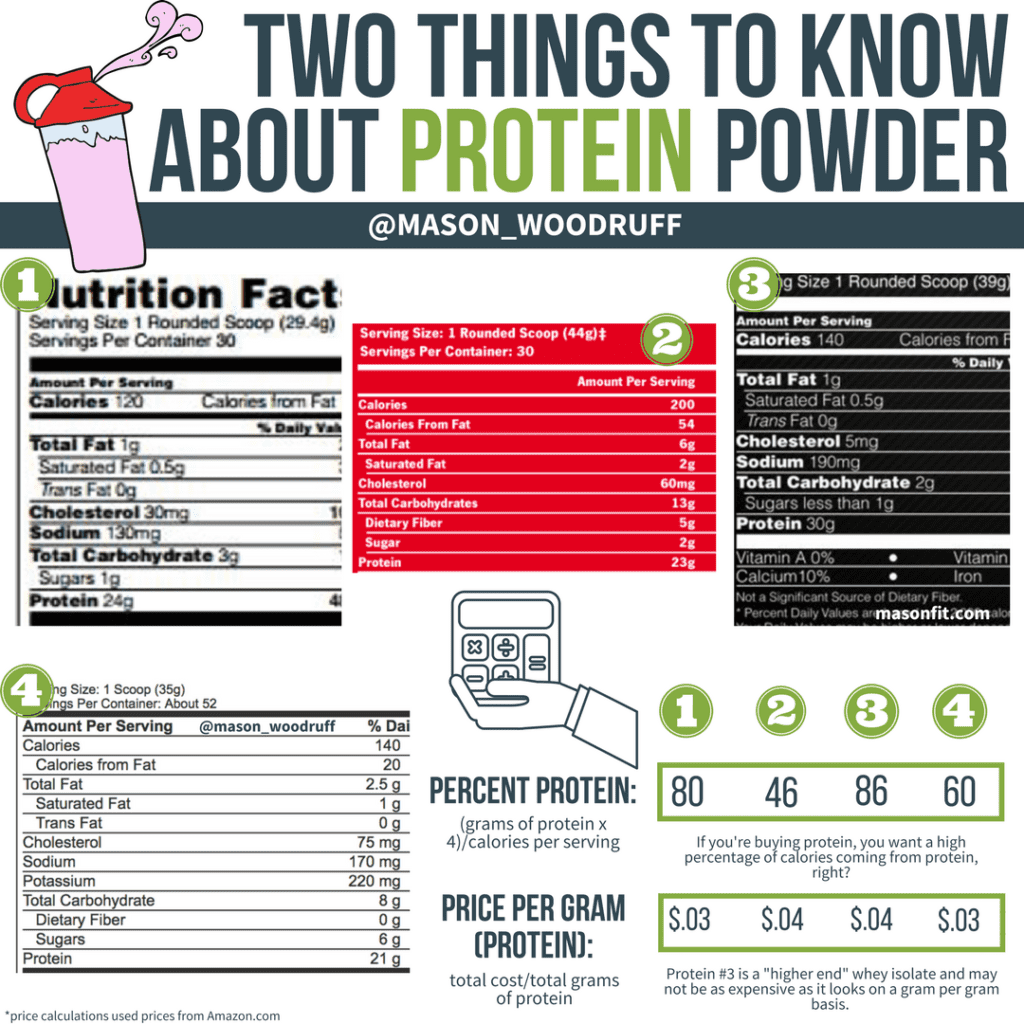
Take a look at these two things the next time you buy protein.
You’re not buying protein for carbs and fat – those things are dirt cheap and readily available. Make sure your protein powder has a high percentage of its calories coming from protein.
To get the true “cost” of protein, look at the price per gram. To find this, simply multiply the grams of protein in a serving by the total servings in a tub. Then divide the cost by the total grams. You might be surprised to find that the cheaper options aren’t the best value.
Can You Absorb More Than 25 Grams of Protein in One Meal?
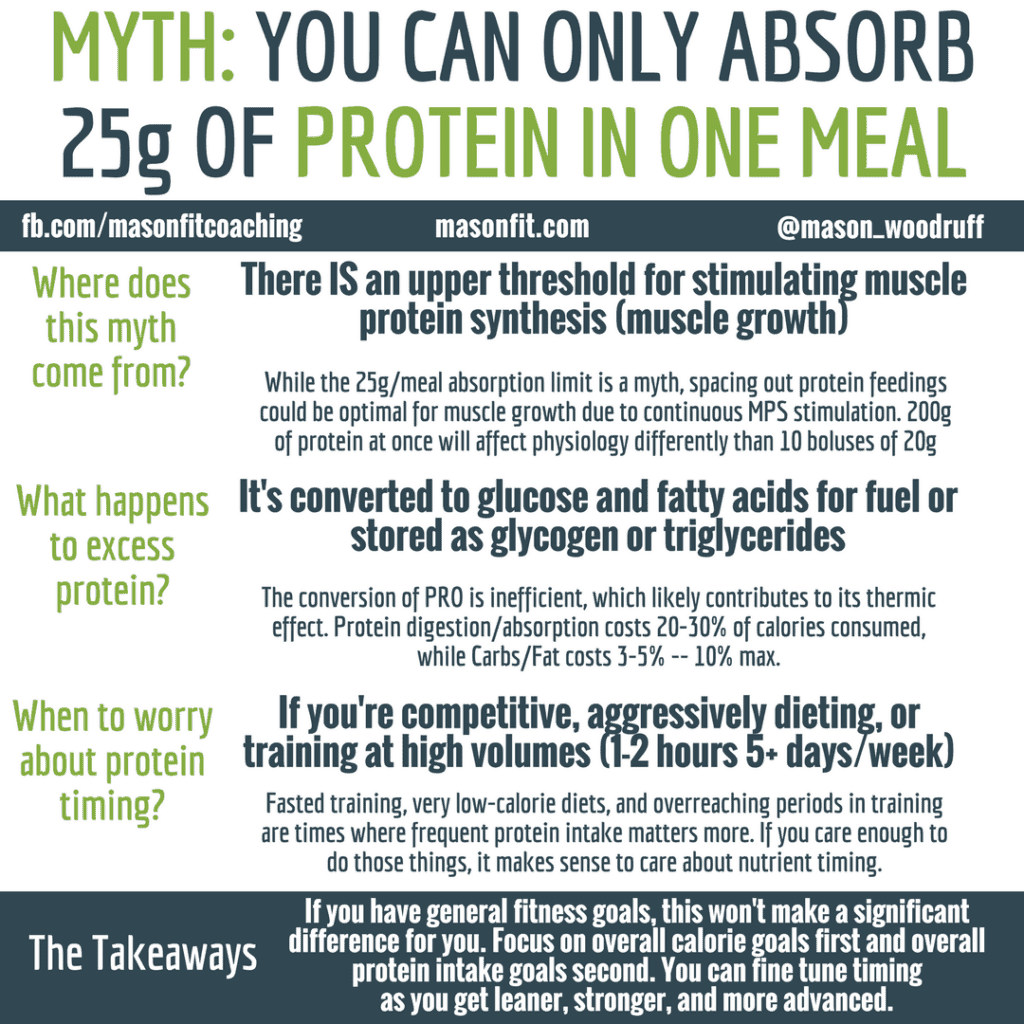
If you eat 50 grams of protein in one meal, will some of that protein go to waste? Nope.
Are you an advanced lifter, competitor, or on the route to becoming elite in the realms of body composition and strength sports? Yes? Then you may want to focus on meal/nutrient timing to optimize performance and recovery. No? Then you should focus on your daily total calorie and protein intake. If you can split your protein up more, cool. If you can’t, cool.
Don’t major in the minors.
How to Tell If Any Supplement Works or If It’s Worth the Money
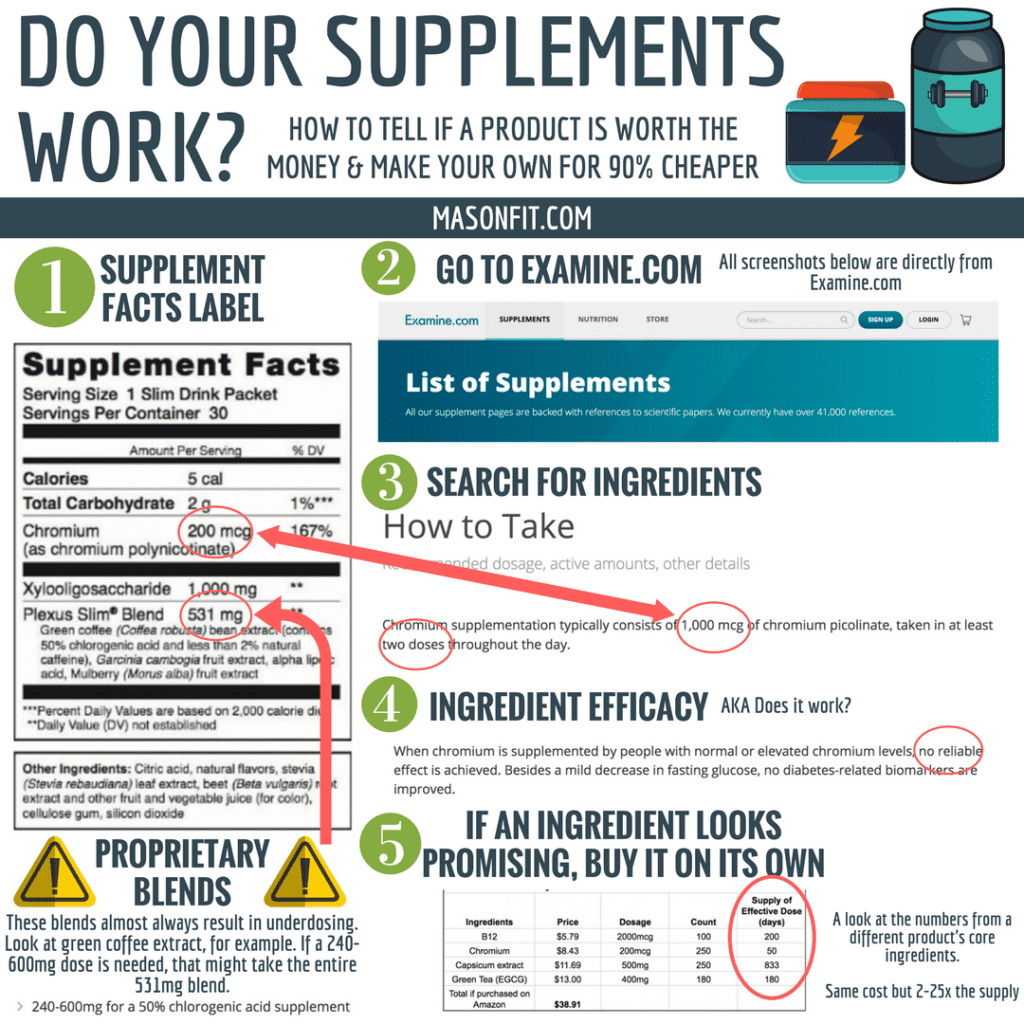
Work through this list using a tool like Examine:
- Have the ingredients been shown to work by research?
- If they have, what’s the recommended dose?
- Does the product’s dose per serving provide adequate amounts?
- Does the product have a proprietary blend on the label? If so, you won’t know how much of each ingredient is there. You can, however, look at the total proprietary blend size and compare the effective doses of each ingredient like I’ve done here. As a whole, it’s probably wise to stay away from proprietary blends. Caffeine is typically present and can provide most of the benefit in a lot of cases. And there are certainly cheaper ways to get caffeine.
- Almost every product boils down to your individual needs. Some ingredients may be the magic ticket for you but not someone else. Try implementing one nutrient at a time (for a month or so) to see if you notice any effects. If not, try something else. When you use the shotgun approach with a product, you have no clue what’s working and what’s not.
- What’s interesting is that if you buy the individual ingredient, it almost always lines up with research-based dose recommendation.
Like I mentioned above, I’ll continue to update this guide over time. If you have any questions about protein powder or supplementation, don’t hesitate to shoot me an email.
And if you’re ready to get baking, check out my protein powder recipes.

dani
Sunday 11th of August 2019
I would like the recipe guide if still available
Mason Woodruff
Thursday 15th of August 2019
Hey Dani, I've updated a recipe guide to a free cookbook here: https://masonfit.com/bone-apple-tea
Kristy
Saturday 10th of August 2019
Love the info Mason